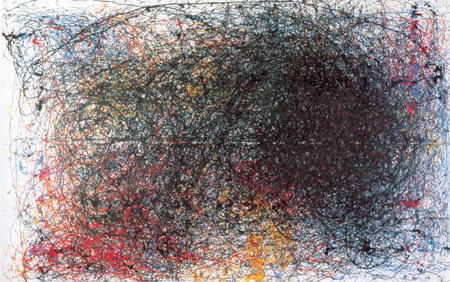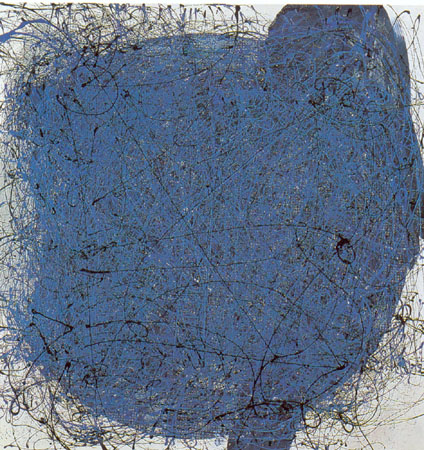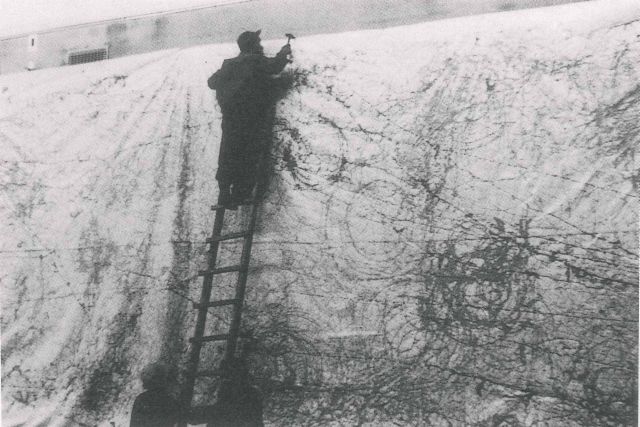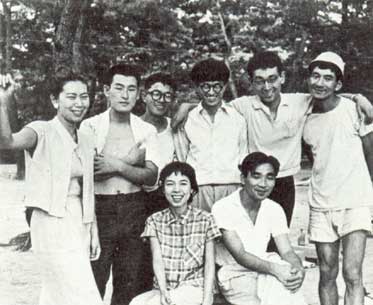
Akira Kanayama’s painting machine from 1957 was a four-wheeled device that Kanayama could remote-control to create paintings approximately 180 by 280 cm. The canvas lay on the floor and the machine dripped and poured paint on the picture pane.
The painting machine is an early example of the machine/robot in the role of artist. Kanayama’s remote-controlled painting machine mimics Jackson Pollock’s drips painting –a technique he developed in the 1940’ties.
At the same time the machine follows Pollock’s ideas of automation and physical detachment between artist and painting, bringing it to a new level, but at the same time it makes fun of role of the artist – no longer an inspired and gesturing artist, but a homemade machine spilling paint. [See comments about Pollock by Dr. Prof. Machiko Kusahara below.]
Text and Pic Source: Electrifying Painting, Ming Tiampo
Kanayama began making his Machine Drawings (fig. 24) in 1957, which were a critique of automatism and the value it placed on self-expression through gestural painting. Kanayama’s Machine Drawings were made by attaching a can of quick-drying paint to an automatic toy car that created paintings whether or not the artist was even in the room…… Both Kanayama and Tanaka used technology as a markmaking instrument. By using a vocabulary of form that had technological rather than psychological origins, Kanayama and Tanaka launched a conceptual attack on the Informel and Abstract Expressionist idea that art could or should be an expression of the soul, poured out and worked on a canvas.



Kanayama hanging his painting done with a remote control mechanical car on vinyl (1957). See Note at bottom.
Source: The Avant-Garde in Exhibition, Altshuler 1994. Photograph – Sinichiro Osaki, Hyogo Prefecture Museum of Modern Art, Kobe, Kyoto Municipal Museum, 1957.
Akira Kanayama was the secretary of the Gutai group. He jokingly said that the position involved so much work that he had no time to paint and instead let a remote-controlled toy car paint for him. The resulting Work (1957) can be seen as a critique against Jackson Pollock’s drip paintings, with which they have some resemblance. In Kanayama, the male genius who expresses his feelings with paint is supplanted by a toy car that randomly zooms around the paper, leaving a trail of paint. Kanayama thus challenged the artist's personal relevance to the quality and ingenuity of the work.

Group photo: Yamazaki, Shiraga, Shimamoto, Murakami, Kanayama, Motonaga,
Tanaka, Ukita.
Pic Source: here.
Both Tanaka (1932 – 2005) and Kanayama (1924 – 2006), two of Japan’s best-known artists, were members of the Gutai Bijutsu Kyokai (Gutai Art Association), an avant-garde art group founded in 1954 in Osaka with the mission to create “an art which has never existed before.” As members of the group, they became famous for seminal pieces with which they remain associated today: Tanaka’s Electric Dress (1956), a jumble of electric cables and lit-up colored lightbulbs which she wore like a garment; and Kanayama’s four-wheel remote control device which enabled him to create automatic Remote-Control Paintings (1957). The artists married and left the group in the mid-1960s, and continued their artistic careers (at a steady pace in Tanaka’s case, in Kanayama’s case more intermittently) through the beginning of the 2000s.
Origins of Japanese Media Art – Artists Embracing Technology from 1950s to Early 1970s
Author: Dr. Prof. Machiko Kusahara
Painting by Machine
The Gutai artist Akira Kanayama is less known compared to his partner Atsuko Tanaka, the artist known for her “Electric Dress (1956), although the original use of technology and interest in materials that had not been traditionally used in art were shared among them. Kanayama helped Tanaka in realizing her ideas that involved technology such as her piece “Work (Bell)” (1955). Kanayama’s “Work” series produced mostly around 1957 involved a remote-controlled car with paint tanks he built himself, modifying a toy car. Kanayama tested a variety of crayons, markers, black and color ink with which the car scribbled or dripped while moving on large pieces of paper and later on white vinyl sheets, which he found the most appropriate for his purpose. While the artist operated the car on a sheet laid on the floor, its trajectory and the resulting traces of ink were never under the perfect control of the artist. Instead of directly employing one’s own body, as in case of other Gutai artists such as Kazuo Shiraga and Saburo Murakami, Kanayama used a mechanical medium and chance operation to drawn lines. His use of plastic inflatables and footsteps on vinyl sheets in other works also suggest his positive interest in new materials, and mediated representation of body. However, when Gutai was “discovered” by the French critic / art dealer Michel Tapié and internationally introduced, these features of Kanayama’s works were disregarded. It is said that his “Work” series was interpreted as alike of Jackson Pollock’s “all-over” style in the art world outside Japan, neglecting the interesting questions that arose about originality and the role of technology in art.
Eventually Gutai artists including Tanaka shifted to “paintings” rather than three-dimensional works involving unusual medium. By the time when Gutai was invited to participate the 1970 World Exposition in Osaka, Kanayama and Tanaka left the group.
Note: Some references give 1955 as the date for Kanayama's Remote-Controlled Painting Machine. The first of the Gutai expositions were in 1955, but I've only been able to trace the machine to the 3rd expositiion held in a Museum in 1957. The 1955 exposition was an outdoor one.
The book Avant-Guard is also confused over these aspects, saying on the one hand the remote drawing machines were new for the 1957 Museum exposition, but also suggesting they were made earlier, but no proof is offered for the 1955 date.
So claims such as ", prefiguring the Métamatic painting machines that the Swiss artist, Jean Tinguely, began to build in 1959." are not correct from two fronts. Tinguely's MetaMatic Drawing Machine No.1 is from 1959, but two earlier drawing machines were built in 1955, the first, called "Machine à Dessiner No. 1"exhibited in the Le Movement exhibition in 1955